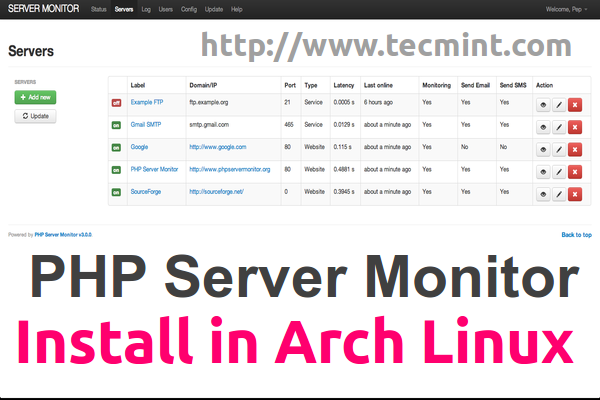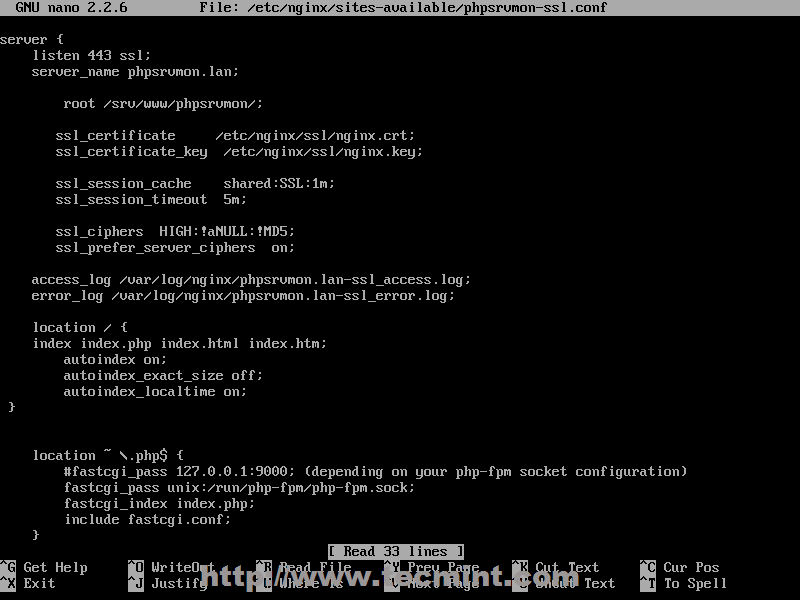

#LINUX WEB MONITOR PHP INSTALL#
Create PHP Server Monitor Database via PhpMyAdmin Step 4: Install PHP Server Monitorġ1. If you have PhpMyAdmin installed on your system you can create PHP Server Monitor database by accessing MySQL/MariaDB from its web interface. MariaDB > quit Create PHP Server Monitor MySQL Database MariaDB > grant all privileges on phpsrvmon.* to MariaDB > create user identified by "user_password"
#LINUX WEB MONITOR PHP PASSWORD#
To create the database needed for PHP Server Monitor to store information, login to MySQL/MariaDB database and create a new database using the following commands (replace database, user and password with your preferred credentials). $ sudo systemctl restart httpd Step 3: Create PHP Server Monitor MySQL Databaseġ0. After all changes are made restart your services to apply changes. date.timezone = Continent/City Set Timezone in PHPĩ. Locate timezone and set your local time as using This Page.

extension=curl.soĮxtension=pdo_mysql.so Enable PHP Extensions Search and enable PHP pdo, mysqli and curl extensions by uncommenting them (remove semicolon from their front). open_basedir = /srv/http/:/home/:/tmp/:/usr/share/pear/:/usr/share/webapps/:/etc/webapps/:/srv/www/ Enable PHP Modules If Nginx/Apache Document Root path has been changed ( default one is /srv/http/) use to locate open_basedir statement and append the new path by prefixing with a colon “ : “ – in this case the new path is /srv/www/ – to look like in the example below. In order to avoid some installation errors, that PHP Server Monitor will throw when it verifies system requirements open php.ini file and make the following adjustments. To generate new SSL Certificate and Key for this Virtual Host use apache_gen_ssl utility, append your domain name on Certificate name and modify /etc/httpd/conf/sites-available/nf file, replacing old SSL Certificate and Key path and names with new ones. Using the same procedure as for Nginx, create Document Root directory, in case the web files served path has changed, activate Apache Virtual Hosts using a2ensite command and restart daemon to apply changes.
#LINUX WEB MONITOR PHP CODE#
$ sudo nano /etc/nginx/sites-available/nfĪdd the following code to the nf file. To add a new Nginx Virtual Host, create a new configuration file on /etc/nginx/sites-available/ with nf name and use the following template as a configuration example. Create Nginx Virtual Host Configuration FilesĢ.

This tutorial uses Virtual Hosting with both web servers ( Nginx and Apache) configured with a local domain fake – phpsrvmon.lan – through /etc/hosts file. Before we start, if your setup uses Virtual Hosting you need to assure that you have valid DNS entry pointing to your domain or use local hosts file in case you don’t have a DNS server. Install LAMP (Linux, Apache, MySQL, PHP) in Arch Linuxġ.To install PHP Server Monitor with Apache use the following guide to setup LAMP stack on Arch Linux. Create Nginx Virtual Hosts in Arch Linux.

Install LEMP (Linux, Nginx, MySQL, PHP) in Arch Linux.To install PHP Server Monitor with Nginx use the following tutorials as guides to setup LEMP stack and Virtual Hosts on Arch. PHP Server Monitor RequirementsĪs general requirements to install and setup PHP Server Monitor for any other Linux platforms, you server needs the following packages installed. This tutorial presents you a way you can install PHP Server Monitor in an Arch Linux server environment using whether Apache as a server or Nginx web server, so, you can choose the installation process that best suits you. It checks websites by using HTTP status code, can displays history graphs of uptime and latency and can use two levels of authentication (administrator and regular user). PHP Server Monitor is an Open Source web frontend monitoring tool written in PHP, that can verify whether the your servers (IP, domains) or services are up and running and can send you notifications via mail services or SMS if a problem occurred on a monitored service or port.


 0 kommentar(er)
0 kommentar(er)
